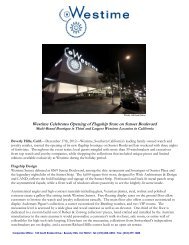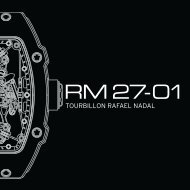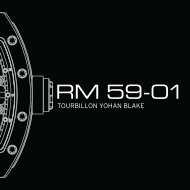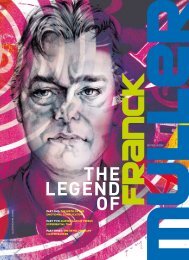The Legend of Franck Muller - Westime
The Legend of Franck Muller - Westime
The Legend of Franck Muller - Westime
Create successful ePaper yourself
Turn your PDF publications into a flip-book with our unique Google optimized e-Paper software.
CHAPTER I - PART I<br />
WHO IS<br />
Every genre <strong>of</strong> art and science has its<br />
era-defining heroes, none more<br />
so than in that unique merger<br />
between mathematics and mayhem<br />
known as mechanical timekeeping. With each<br />
period in horology, one watchmaker has<br />
stepped forward to be the definitive genius <strong>of</strong><br />
his time. Each <strong>of</strong> these men has not just<br />
brought about advancements in watchmaking,<br />
but also shaped our cultural destiny.<br />
Though there have been many watchmakers<br />
who have contributed enormously to the<br />
landscape <strong>of</strong> the 20th century, there is one<br />
individual whose impact has been extraordinary.<br />
He would be the first great horological icon after<br />
watchmaking faced its greatest threat ever. He<br />
would usher in a new golden era for high<br />
watchmaking that would simultaneously connect<br />
its values to an all-new generation while<br />
completely redefining the significance <strong>of</strong> the<br />
wristwatch in contemporary culture.<br />
His name is <strong>Franck</strong> <strong>Muller</strong>, and this is his story.<br />
In many ways, <strong>Franck</strong>’s story stretches back<br />
centuries before he was born. It began with the<br />
ancient Sumerians as they first traced the<br />
passage <strong>of</strong> the day. It has its roots in the mid-<br />
14th century when Giovanni de’ Dondi <strong>of</strong> Padua<br />
would create one <strong>of</strong> the most ambitious<br />
instruments to capture the fleeting eternity we<br />
perceive as time. De’ Dondi’s ambition was to<br />
transcend the mere tracking <strong>of</strong> civil time and<br />
communicate a greater revelation <strong>of</strong> our planet’s<br />
orbit around the sun. His Astrarium was based<br />
on the writings <strong>of</strong> the renowned astronomer<br />
Johannes Campanus, and it was, simply<br />
speaking, the most advanced astronomical clock<br />
and planetarium <strong>of</strong> its time.<br />
<strong>Franck</strong>’s story is similarly rooted in that <strong>of</strong> a<br />
Yorkshire cabinetmaker turned horologist, John<br />
Harrison. Determined to give England a clock<br />
accurate enough to provide position at sea,<br />
Harrison’s H4, presented in 1761, represented<br />
31 years <strong>of</strong> unremitting labor and was the tool<br />
that allowed man to navigate the world beyond<br />
the horizon. <strong>Franck</strong>’s precursors include<br />
Abraham-Louis Breguet, the consummate<br />
showman and watchmaker whose iconic<br />
inventions include the tourbillon regulator;<br />
Christiaan Huygens, inventor <strong>of</strong> the hairspring;<br />
Pierre Le Roy, innovator <strong>of</strong> the detent<br />
escapement; Ferdinand Berthoud, fabricator <strong>of</strong><br />
the world’s most revered marine chronometers;<br />
Charles Édouard Guillaume, Nobel Prizewinning<br />
inventor <strong>of</strong> the thermal-compensating<br />
balance spring material, Elinvar. But while each<br />
<strong>of</strong> these men labored to bring a new chapter to<br />
the story <strong>of</strong> high horology, <strong>Franck</strong> <strong>Muller</strong>’s<br />
immense challenge would be to keep the story <strong>of</strong><br />
mechanical watchmaking itself alive.<br />
<strong>The</strong> era in which he came to prominence<br />
was when the watch industry attempted to<br />
rebuild itself after suffering its most brutal<br />
and devastating assault in its 300-year-old<br />
history. It would be <strong>Franck</strong> who would<br />
become its greatest vehicle for rebirth.<br />
<strong>Franck</strong> would achieve this rebirth based on<br />
three pillars. <strong>The</strong> first involved his reintroduction<br />
<strong>of</strong> classical Swiss high watchmaking renewed<br />
through aesthetic innovation and technical<br />
audacity to an all-new audience. A chief example<br />
<strong>of</strong> this is his introduction <strong>of</strong> one <strong>of</strong> watchmaking’s<br />
most famous complications, the tourbillon<br />
regulator, to the wristwatch. <strong>The</strong> second required<br />
<strong>Franck</strong> to use his dexterity to meet the needs <strong>of</strong><br />
the modern world. A prime example <strong>of</strong> this is his<br />
creation <strong>of</strong> the revolutionary Master Banker, a<br />
watch that enables its user to simultaneously<br />
keep track <strong>of</strong> three time zones. Finally, <strong>Franck</strong><br />
also transformed the watch from a precision<br />
instrument into a canvas for the emotional<br />
expression <strong>of</strong> time. His Crazy Hours watch<br />
would delight and shock by creating a seemingly<br />
random jumble <strong>of</strong> numbers on the dial, yet the<br />
hands would always find their way to the correct<br />
index as if guided by some divine intervention.<br />
the young prodigy<br />
Who is <strong>Franck</strong> <strong>Muller</strong>? He is part showman, part<br />
technical prodigy… part impresario and part<br />
elusive genius. <strong>Muller</strong> was born in 1958 to an<br />
Italian mother and a Swiss father, and in many<br />
ways, his equal footing in these cultures would<br />
define the watchmaker he would become<br />
because encoded within his DNA were the<br />
design acumen, aesthetic bravado and reverence<br />
for science that typified Italian watchmaking, as<br />
well as the dedication to precision and the<br />
respect for the traditional values that are at<br />
the root <strong>of</strong> Swiss watch culture.<br />
This concept <strong>of</strong> duality inhabiting <strong>Muller</strong> is<br />
fitting indeed, because in many ways, he would<br />
influence both the past and the future <strong>of</strong><br />
watchmaking. By reaching back to its historic<br />
roots, he brought an all-new relevance to its<br />
mythical language <strong>of</strong> complications; and<br />
by transmitting the value <strong>of</strong> gearwheels,<br />
hairsprings and balances to an all-new<br />
contemporary world, he defined its future.<br />
<strong>Franck</strong> enacted a rebirth for horology that<br />
continues to be the single biggest influence<br />
on the shape <strong>of</strong> contemporary horology today.<br />
Says independent watchmaking legend, Philippe<br />
Dufour, “What is clear is that without<br />
<strong>Franck</strong> <strong>Muller</strong>, watchmaking would not exist<br />
at the same level <strong>of</strong> cultural relevance as it<br />
does today.” Michel Parmigiani, another<br />
Swiss horological hero, states: “<strong>Franck</strong><br />
may very well be one <strong>of</strong> the most talented<br />
individuals to take up the craft <strong>of</strong> watchmaking.”<br />
“What is clear is<br />
that without<br />
franck muller,<br />
watchmaking<br />
would not exist<br />
at the same level<br />
<strong>of</strong> cultural<br />
relevance as it<br />
does today”<br />
— independent<br />
watchmaking legend,<br />
philippe Dufour









